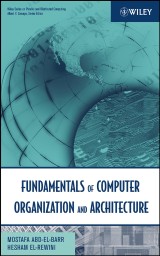Details

Fundamentals of Computer Organization and Architecture
Wiley Series on Parallel and Distributed Computing, Band 38 1. Aufl.
|
147,99 € |
|
| Verlag: | Wiley |
| Format: | |
| Veröffentl.: | 22.02.2005 |
| ISBN/EAN: | 9780471478331 |
| Sprache: | englisch |
| Anzahl Seiten: | 288 |
DRM-geschütztes eBook, Sie benötigen z.B. Adobe Digital Editions und eine Adobe ID zum Lesen.
Beschreibungen
This is the first book in the two-volume set offering comprehensive coverage of the field of computer organization and architecture. This book provides complete coverage of the subjects pertaining to introductory courses in computer organization and architecture, including:<br /> * Instruction set architecture and design<br /> * Assembly language programming<br /> * Computer arithmetic<br /> * Processing unit design<br /> * Memory system design<br /> * Input-output design and organization<br /> * Pipelining design techniques<br /> * Reduced Instruction Set Computers (RISCs)<br /> The authors, who share over 15 years of undergraduate and graduate level instruction in computer architecture, provide real world applications, examples of machines, case studies and practical experiences in each chapter.
Preface. <p>1. Introduction to Computer Systems.</p> <p>1.1. Historical Background.</p> <p>1.2. Architectural Development & Styles.</p> <p>1.3. Technological Development.</p> <p>1.4. Performance Measures.</p> <p>1.5. Summary.</p> <p>Exercises.</p> <p>References and Further Reading.</p> <p>2. Instruction Set Architecture & Design.</p> <p>2.1. Memory Locations and Operations.</p> <p>2.2. Addressing Modes.</p> <p>2.3. Instruction Types.</p> <p>2.4. Programming Examples.</p> <p>2.5. Summary.</p> <p>Exercises.</p> <p>References and Further Reading.</p> <p>3. Assembly Language Programming.</p> <p>3.1. A Simple Machine.</p> <p>3.2. Instructions Mnemonics and Syntax.</p> <p>3.3. Assembler Directives and Commands.</p> <p>3.4. Assembly and Execution of Programs.</p> <p>3.5. Example: The X 86 Family.</p> <p>3.6. Summary.</p> <p>Exercises.</p> <p>References and Further Reading.</p> <p>4. Computer Arithmetic.</p> <p>4.1. Number Systems.</p> <p>4.2. Integer Arithmetic.</p> <p>4.3. Floating Point Arithmetic.</p> <p>4.4. Summary.</p> <p>Exercises.</p> <p>References and Further Readings.</p> <p>5. Processing Unit Design.</p> <p>5.1. CPU Basics.</p> <p>5.2. Register Set.</p> <p>5.3. Data Path.</p> <p>5.4. The CPU Instruction Cycle.</p> <p>5.5. Control Unit.</p> <p>5.6. Summary.</p> <p>Exercises.</p> <p>References.</p> <p>6. Memory System Design I.</p> <p>6.1. Basic Concepts.</p> <p>6.2. Cache Memory.</p> <p>6.3. Summary.</p> <p>Exercises.</p> <p>References and Further Readings.</p> <p>7. Memory System Design II.</p> <p>7.1. Main Memory.</p> <p>7.2. Virtual Memory.</p> <p>7.3. Read-Only Memory.</p> <p>7.4. Summary.</p> <p>Exercises.</p> <p>References and Further Readings.</p> <p>8. Input-Output Design and Organization.</p> <p>8.1. Basic Concepts.</p> <p>8.2. Programmed I/O.</p> <p>8.3. Interrupt-Driven I/O.</p> <p>8.4. Direct Memory Access (DMA).</p> <p>8.5. Busses.</p> <p>8.6. Input-Output Interfaces.</p> <p>8.7. Summary.</p> <p>Exercises.</p> <p>References and Further Readings.</p> <p>9. Pipelining Design Techniques.</p> <p>9.1. General Concepts.</p> <p>9.2. Instruction Pipeline.</p> <p>9.3. Arithmetic pipeline.</p> <p>9.4. Summary.</p> <p>Exercises.</p> <p>References and Further Reading.</p> <p>10. Reduced Instruction Set Computers (RISCs).</p> <p>10.1. RISC/CISC Evolution Cycle.</p> <p>10.2. RISCs Design Principles.</p> <p>10.3. Overlapped Register Windows.</p> <p>10.4. RISCs Versus CISCs.</p> <p>10.5. Pioneer (University) RISC Machines.</p> <p>10.6. Example of Advanced RISC Machines.</p> <p>10.7. Summary.</p> <p>Exercises.</p> <p>References and Further Readings.</p> <p>11. Introduction to Multiprocessors.</p> <p>11.1. Introduction.</p> <p>11.2. Classification of Computer Architectures.</p> <p>11.3. SIMD Schemes.</p> <p>11.4. MIMD Schemes.</p> <p>11.5. Interconnection Networks.</p> <p>11.6. Analysis and Performance Metrics.</p> <p>11. 7. Summary.</p> <p>Exercises.</p> <p>References and Further Readings.</p> <p>Index. </p>
"The book takes its value from being very well organized, concise, and clear." (<i>CHOICE</i>, July 2005) <p>"In addition to being an excellent tool for students, this is a thorough and dependable reference for engineers and programmers." (<i>International Journal of General Systems</i>, June 2005)</p> <p>"...a textbook that is useful as an introduction to computer organization fundamentals…" (<i>Computing Reviews.com</i>, March 10, 2005)</p>
MOSTAFA ABD-EL-BARR, PhD, is currently a professor and chairman of the Department of Information Science at Kuwait University. He has co-authored two other books, published more than 120 papers, and served as chair for a number of international conferences and symposia. <p>HESHAM EL-REWINI, PhD, PE, is a full professor and chairman of the Department of Computer Sciences and Engineering at Southern Methodist University (SMU). He has co-authored several books, published numerous research papers in journals and conference proceedings, and chaired many international conferences.</p>
An invaluable and comprehensive resource on computer organization and architecture <p>Typically, instructors of computer organization and architecture courses have had to resort to multiple textbooks as well as supplementary notes to provide students with adequate learning material. Fundamentals of Computer Organization and Architecture provides a more coherent approach by covering all the necessary topics in one single textbook, including:</p> <ul> <li>Instruction set architecture and design</li> <li>Assembly language programming</li> <li>Computer arithmetic</li> <li>Processing unit design</li> <li>Memory system design</li> <li>Input-output design and organization</li> <li>Pipeline design techniques</li> <li>Reduced Instruction Set Computers (RISCs)</li> <li>Introduction to multiprocessors</li> </ul> <p>This comprehensive and didactic resource provides an introduction to computer systems, including historical background, to provide a context and framework for concepts and applications developed in subsequent chapters; case examples of real-world computer systems that illuminate key concepts and demonstrate practical applications; and exercises, summaries, references, and further reading recommendations at the end of each chapter.</p> <p>Fundamentals of Computer Organization and Architecture simplifies course material development for instructors with its comprehensive coverage and helps the readers learn faster thanks to its logical organization, clear style, and practical examples. In addition to being an excellent teaching tool for students, this is a thorough and dependable reference for engineers and programmers.</p>
Diese Produkte könnten Sie auch interessieren:

Data Mining and Machine Learning Applications

von: Rohit Raja, Kapil Kumar Nagwanshi, Sandeep Kumar, K. Ramya Laxmi

190,99 €
















